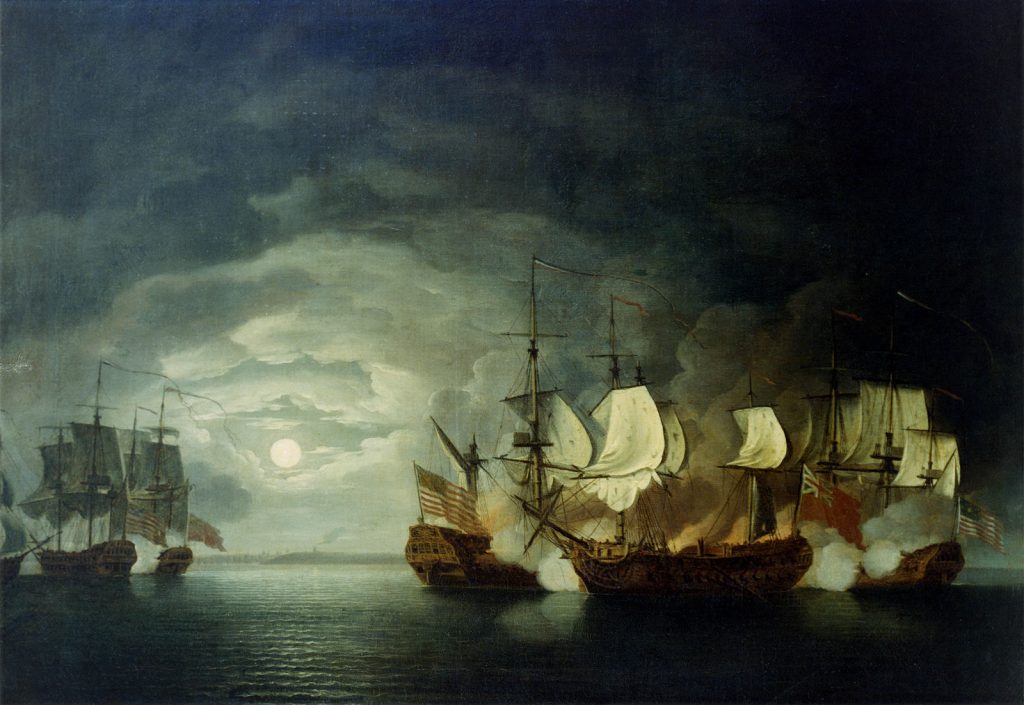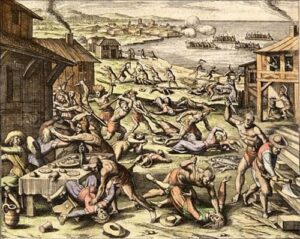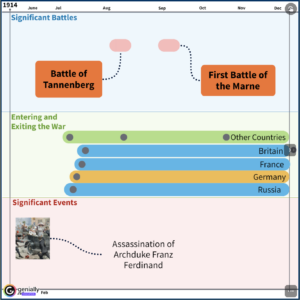Winner of the Spring 2019 StMU History Media Award for
Best Article in the Category of “United States History”
The Spring months of 1779 had been uneventful, almost boring for Commodore John Paul Jones of the Continental Navy. He spent most of his time in France overseeing the refitting of his squadron and the outfitting of his new flagship the Bonhomme Richard. As the Spring passed, Jones grew increasingly anxious over his lack of action in the American War for Independence. It was not natural for him to sit by and do nothing in any situation, much less in his young nation’s fight for independence from Great Britain. The beginning of Summer was not much more eventful. Jones and his squadron were relegated to mere convoy duty escorting French merchant vessels in the English channel and the Bay of Biscay. It was a tedious task, and Jones was unable to engage any British warships.1 He craved to return to sea and continue the fight against the Royal Navy. He was desperate for a battle and despised the Royal Navy with an almost obsessive self destructive hatred. He wanted nothing more than to destroy every Royal Navy ship he encountered at sea.2 Finally, at the beginning of August 1779, Jones received orders from the American ambassador in France, Benjamin Franklin, to pursue merchant vessels sailing in British territorial waters. This was the chance that John Paul Jones had been waiting for; a chance to resume his attacks against the British merchant marine and the Royal Navy in their own waters. The feat was extremely dangerous, but no one was better equipped than the fiery audacious Jones. So, at 4:00 a.m on 14 August, Jones and his squadron of six ships set sail from the French port of Groix Roadstead bound for British waters.3 He did not know it then, but John Paul Jones had embarked on the cruise that would immortalize his name in American history forever.
Jones was in high spirits as his cruise around the British Isles began. With the land behind him, he was free to do what he liked as commander of his squadron, and he began capturing prizes within three days of his departure from France. His squadron took its first prize on 18 August and then captured a British vessel, Mayflower, laden with food provisions bound for London. The prizes were good, but Jones had trouble keeping his squadron together all the same. Some of his ships were separated in violent storms, which are so common in the waters of the Irish and North Seas, while some vessels wandered off on their own accord only to reappear when their captains saw fit. Nevertheless, Jones carried on his crusade. At noon on 1 September he took Union, a British vessel carrying uniforms for an army in Quebec. On the 16th, Jones took aboard a yacht captain who desired gun powder for his employer for protection from John Paul Jones. Commodore Jones proceeded to ask the yacht captain if he knew who he was speaking to, and the yacht captain replied that he was speaking to Captain Johnston of H.M.S. Romney. Jones, no doubt having fun at this point replied, “No I am Paul Jones.”4 His mistake revealed to him, the man fell to his knees and begged for mercy. Jones happily spared his life, but the yacht captain was taken prisoner. He then proceeded up the coast of Scotland, where his presence created widespread consternation and fear, but he was unable to make landfall anywhere due to incessant bickering with his subordinates and a disadvantageous shift in the wind the night of the landing. Up to that point, the mission was entirely normal; Jones was accustomed to taking prizes, dealing with the oddities of life at sea, as well as handling insubordination from the captains under his command. He had no idea that his date with fame, glory, and immortality was just around the corner.5
John Paul Jones’ day began early on September 23, 1779. He hoped to rendezvous with some of his rouge ships, and reunite them with the rest of his squadron. At 5:30 a.m the frigates Alliance and Pallas rejoined Jones on the Bonhomme Richard, and together with a small prize they had taken, brought Jones’ squadron up to four vessels. Jones ordered the squadron to sail slowly toward Flamborough Head. At 3:00 p.m he spotted a large convoy of forty-one merchant vessels. This was it. This was the moment that Jones had been waiting for. He would love nothing more than to destroy and scatter the enemy’s merchant fleet, but he knew that every merchant convoy was accompanied by a powerful escort of at least two warships. The two escorts that accompanied this merchant fleet were the fifty-gun warship Serapis and the smaller twenty-gun vessel Countess of Scarborough. It was time for Jones to act, but his opponents beat him to action. Captain Richard Pearson, of the Serapis, ordered his convoy away to safety along the English coast. He then positioned his ships between Jones’ squadron and the merchant convoy. Jones, seeing this, ordered his ships to give chase, and began preparations for battle. Sailors rushed to and fro, taking their assigned positions on deck, preparing cannons for battle, and passing out hand-held weapons. At 6:00 p.m Jones hoisted his blue signal flag notifying the three ships to form a line of battle. Leading the line was Alliance, followed by Bonhomme Richard, and then finally Pallas brought up the rear. The three vessels slowly sailed towards their opponents, then suddenly both the Alliance and Pallas dropped out of the line of battle (this was a touch of the aforementioned insubordination manifesting itself at the worst possible time). Jones was utterly shocked, but he was nevertheless determined to engage his powerful foe; even if that meant doing it alone.6

Finally, at 6:30 p.m, just as the sun was setting behind the horizon, Jones sailed the lone Bonhomme Richard on a parallel course with Serapis. It was not long before the two vessels were within pistol shot of each other. Jones, who had up to that point been flying a British flag, tore it down and replaced it with the flag of his young nation. The cannons of the two vessels opened fire with ear shattering force. The red flashes of gunpowder exploding from the cannons were harbingers of death to the men on both decks. Within seconds, they were inundated by smoke as cannon balls crashed into wood and limb alike. Loose splinters of wood easily pierced sailors’ skin inflicting excruciating pain. The decks of both ships rang out with terrible cries of suffering and death. It truly was a horrific scene.7 In the thick of it all was John Paul Jones. He thrived in such a situation; he could be seen in the blue uniform of the Continental Navy barking orders to his men and fighting gallantly alongside them in the battle. Still though things were looking bleak. The Countess of Scarborough was firing her cannons at the stern of the Bonhomme Richard, unchallenged by either of Jones’ allies. Then disaster struck; half a dozen cannons stationed on the Bonhomme Richard’s deck exploded. The deck of the ship belched fire and smoke, while wounded men laid dying in the embers of the resultant fire or simply refused to fight any longer. Jones knew that he could not sustain much more damage, and he decided to order his remaining men to use grappling hooks to draw the Serapis into a deadly embrace. The tools were laid out, and the feat was performed successfully; the two ships were now intertwined. The firing of the Countess of Scarborough ceased, but despite that, the fighting was deadlier than ever. Both crews attempted to rush the boat deck of the enemy ship only to be turned back by the sheer determination of their foes. The two vessels, battered and beaten as they were, fought to a stalemate. However, Jones’ prudence and luck soon began to turn the tide of battle.8

By 9:00 p.m. the moon shone brightly in the sky revealed the truly terrible sight below. Both vessels were lit by the intense fires on deck, men laid wounded and dying with blood covering their clothes and skin. Some were missing whole limbs. Still, the battle raged on. There still was John Paul Jones, untouched and unmoved by the perils of battle, and curious as to what to do next. He soon realized that if he could muster his three remaining guns he might be able to destroy the mast of the Serapis. Working side by side with his remaining crew, they pointed the last of the guns at the large yellow mast of the enemy ship. Off the cannon balls went towards their weakened prey, hoping to score a crippling shot. As events unfolded on the boat deck, it became clear to those men on the lower decks that the ship was taking on too much water. The Bonhomme Richard was sinking. Those working below rushed up on the boat deck, and, thinking of nothing but saving their lives, did not join their fellow crew mates in combat, but rather attempted to flee the battle. As pandemonium overtook the boat deck, a rumor reached the master gunner, Henry Gardner, that John Paul Jones and his lieutenant had been killed in action, and that he was now captain. With no time to check the truthfulness of this rumor, Gardner rushed to haul down the American Flag and surrender. Captain Pearson, seeing this, asked, “Do you ask for quarter?”9 Jones, still very much alive and fighting, replied, “No, sir, I haven’t as yet thought of it, but I’m determined to make you strike.”10 Indeed, this was true and the battle raged on just as fierce as before. The cannons of the Serapis had ripped so many holes in Bonhomme Richard that its cannon balls simply sailed through the air, in one side and out the other. The Serapis itself had lost its mainmast, which lay crippled on its side supported only by the deck of Bonhomme Richard. However, one side had to win eventually, and John Paul Jones’ luck soon began to change. La Pallas and Alliance, which up to that point had been absent from the battle, joined the fray. La Pallas engaged the Countess of Scarborough and forced her to surrender. Then, Alliance opened fire on Serapis and Bonhome Richard, sending cannon balls hurling towards the already crippled ships. Jones and his men on deck yelled out for Alliance to stop as she was putting her fellow sailors in danger. Alliance delivered one last broadside, and then sailed off away from danger, never to offer assistance again (Alliance’s captain despised Jones, and this half-minded attempt at assistance was a manifestation of insubordination as well). Above the decks, a Scottish-American sailor had been tossing grenades at enemy crewmen all night. He managed to toss three grenades into the hatchway of Serapis and ignite one of her guns and create a massive explosion. With that, Captain Pearson decided to strike his colors and surrender his ship. John Paul Jones and his crew were victorious.11
The battle ended at approximately 10:40 p.m. Both sides had fought so bravely and suffered so dearly. In accordance with standard eighteenth-century protocol, Jones invited Captain Pearson on board his shattered vessel for a drink after accepting his surrender. The two captains had been enemies, but now they had no choice but to work together to reach shore. The next day, September 24, after making every effort to save Bonhomme Richard, John Paul Jones was forced to leave her lost to the sea. No matter, for he had a brand new ship and a fine one at that. However, he had paid dearly for it. Jones recorded 150 men killed or wounded of a crew of 322, while Pearson had lost at least a hundred as well. The battle had been one of the most gruesome and bloody affairs of the Age of Sail. Nevertheless, when he returned to France, he was hailed as a hero by all, including Benjamin Franklin and King Louis XVI. Jones had gained his place in the pantheon of American heroes, and it is one that he still rightly holds to this day. Strategically, the battle counted for nothing—the British still ruled the waves—but the battle provided the groundwork on which a proud naval tradition of the new United States could be built.12

- Samuel Eliot Morison, John Paul Jones: A Sailor’s Biography (Boston: Little, Brown and Company, 1959), 193-197. ↵
- Arthur Herman, To Rule the Waves: How the British Navy Shaped the Modern World (New York: Harper Perennial, 2005), 311. ↵
- Samuel Eliot Morison, John Paul Jones: A Sailor’s Biography (Boston: Little, Brown and Company, 1959), 198. ↵
- John Paul Jones, quoted in Samuel Eliot Morison, John Paul Jones: A Sailor’s Biography (Boston: Little, Brown and Company, 1959), 218. ↵
- Samuel Eliot Morison, John Paul Jones: A Sailor’s Biography (Boston: Little, Brown and Company, 1959), 207-212, 216-218. ↵
- Samuel Eliot Morison, John Paul Jones: A Sailor’s Biography (Boston: Little, Brown and Company, 1959), 226-228. ↵
- Samuel Eliot Morison, John Paul Jones: A Sailor’s Biography (Boston: Little, Brown and Company, 1959), 229. ↵
- John Paul Jones, Memoir of the American Revolution presented to King Louis XVI of France (Washington D.C: American Revolution Bicentennial Office, Library of Congress, 1979), 33. ↵
- John Pearson, quoted in John Paul Jones, John Paul Jones’ Memoir of the American Revolution Presented to King Louis XVI of France ( Washington D.C: American Revolution Bicentennial Office, Library of Congress, 1979), 35. ↵
- John Paul Jones, quoted in, John Paul Jones, John Paul Jones Memoir of the American Revolution presented to King Louis XVI of France (Washington D.C: American Revolution Bicentennial Office, Library of Congress, 1979 ), 35. ↵
- John Paul Jones, John Paul Jones’ Memoir of the American Revolution presented to King Louis XVI of France ( Washington D.C: American Revolution Bicentennial Office, Library of Congress, 1979), 35-38. ↵
- Samuel Eliot Morison, John Paul Jones: A Sailor’s Biography (Boston: Little, Brown and Company, 1959), 243-244. ↵




86 comments
Brandon Vasquez
This article was really well written and it does not surprise me that this article won Best Article in the Category of “United States History” so congratulations for winning that. I really liked how much detail was put into the article so the reader can understand how hard-fought the battle was between the two sides. I feel like this article really put the reader on the battlefield as well and because of that it allowed for me to understand this battle more.
Brandon Vasquez
This article was really well written and it does not surprise me that this article won Best Article in the Category of “United States History” so congratulations on that. I really liked how much detail was put into the article so the reader can understand how hard-fought the battle was between the two sides. I feel like this article really put the reader on the battlefield as well and because of that it allowed for me to understand this battle more.
Dejah Garcia
What a fantastic article! I love how you used the imagery in your report to portray to your audience the message behind your writing. This stood out because it helped me connect to the reading and gain more interest. Another thing that stood out to me was your writing format! I loved how you structured your article. It as super organized! This was important to me because it helped me understand your message better!
Angelo Oliva-Noeggerath
The article has great attention to detail as it does not fail to tell the reader about the events that occur and it even led me to learn that there were things as traditional as having a drink with the other ship’s captain after their ship is sunk. The pictures add to the article as it shows the scene of the battlefield on water and how it was pictured or seen to be. Congratulations on the award for United States History the award reflects the effort you put into the article and is well deserved.
Claudia Sanchez
Wow. This article was a beautiful and capturing telling of one of John Paul Jones’ greatest and bloodiest naval battles. When l have learned about the American Revolution there was always more emphasis on the land fighting that took place so this article was a really interesting perspective that I am not used to discussing. Love the way you began this article. Congradulations on the award!
Jaedean Leija
As we read an incredible article about John Paul Jones we learn about his passion and the amazing things he did during his time. The way Christopher Hohman was able to describe and tell the story as if we could close our eyes and picture it all as if we were there in that time is very incredible. I enjoyed learning about Jones and I enjoyed reading this article as well, I want to read more and follow up on Hohman’s articles.
Aaron Onofre
What a great story! The passion that Commodore John Paul Jones had is so inspiring to read about. His never give up attitude in the face adversity and opposition is one of a kind. Even when his men were insubordinate he was not fazed, he kept marching forward or in this case sailing forward. I believe Commodore John Paul Jones is the true embodiment of unaltered pride for his country, which is now our country, The United States of America.
Daniela Iniguez-Jaco
First, congratulations on the award! I can definitely see why you earned the award, this piece was magnificent to read! I enjoyed getting to read about Jones, I will be honest at first I thought Jones was a selfish person for wanting to look for trouble since he is risking the lives of his crewmates. However, once I continued reading I understood why he wanted to fight, I appreciate his effort to fight. A part that stuck with me was the event that occurred on August 18, when they captured a British vessel, that stuck with me because that is my birthday!
Matthew Gallardo
I’m very glad I got the chance to read this article. I always wanted to read up more on John Paul Jones and his incredible tenacity and exploits. I’m glad this article gave me ample opportunity to. It was a very interesting and intriguing read, with the chronological order of one of John Paul Jones’ greatest victories, starting even before the battle was planned, to the end with losing a ship and gaining another.
Kensley Dieckow
Congratulations on best US history article, this was really interesting and I don’t think I would’ve thought this topic would be so interesting. It really was though. You did a great job painting a picture of the timeline that day and it keeps you on your toes. Your style of writing really tells a story and I enjoyed reading your article.